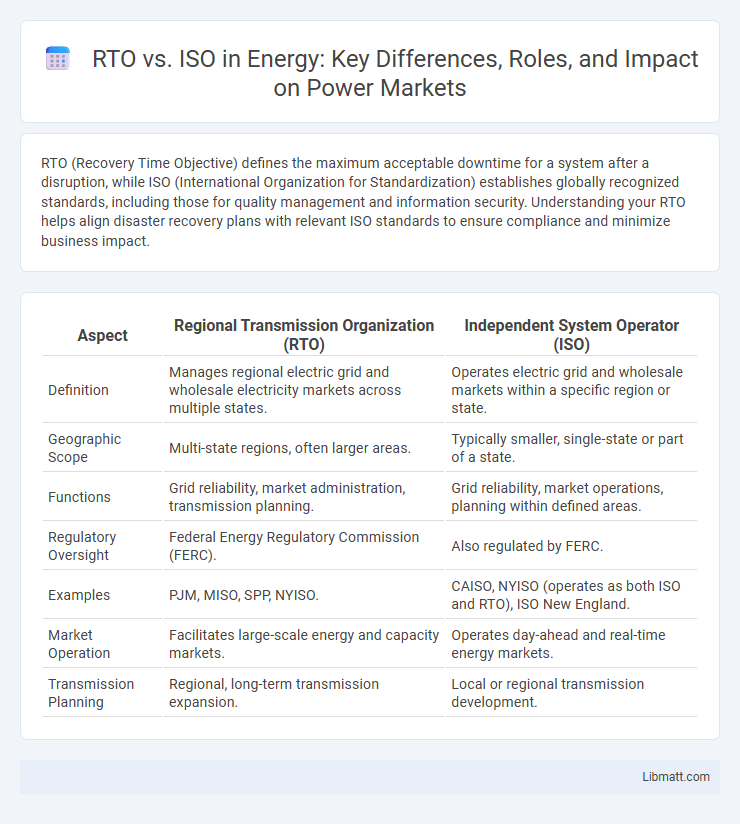RTO (Recovery Time Objective) defines the maximum acceptable downtime for a system after a disruption, while ISO (International Organization for Standardization) establishes globally recognized standards, including those for quality management and information security. Understanding your RTO helps align disaster recovery plans with relevant ISO standards to ensure compliance and minimize business impact.
Table of Comparison
| Aspect | Regional Transmission Organization (RTO) | Independent System Operator (ISO) |
|---|---|---|
| Definition | Manages regional electric grid and wholesale electricity markets across multiple states. | Operates electric grid and wholesale markets within a specific region or state. |
| Geographic Scope | Multi-state regions, often larger areas. | Typically smaller, single-state or part of a state. |
| Functions | Grid reliability, market administration, transmission planning. | Grid reliability, market operations, planning within defined areas. |
| Regulatory Oversight | Federal Energy Regulatory Commission (FERC). | Also regulated by FERC. |
| Examples | PJM, MISO, SPP, NYISO. | CAISO, NYISO (operates as both ISO and RTO), ISO New England. |
| Market Operation | Facilitates large-scale energy and capacity markets. | Operates day-ahead and real-time energy markets. |
| Transmission Planning | Regional, long-term transmission expansion. | Local or regional transmission development. |
Introduction to RTO and ISO
RTO (Recovery Time Objective) defines the maximum acceptable downtime for a business process after a disruption, determining the speed at which systems must be restored. ISO (International Organization for Standardization) develops globally recognized standards, including ISO 22301, which specifies requirements for business continuity management systems. Both RTO and ISO standards are critical components in designing effective business continuity and disaster recovery strategies.
Understanding RTO: Definition and Purpose
Recovery Time Objective (RTO) defines the maximum acceptable duration within which a business process or IT system must be restored after a disruption to avoid unacceptable consequences. It serves as a critical benchmark in disaster recovery and business continuity planning, guiding the development of strategies to minimize downtime. Organizations establish RTO based on the impact analysis of operational losses, customer dissatisfaction, and revenue decline to ensure timely recovery aligned with business needs.
What is ISO? Overview and Standards
ISO, the International Organization for Standardization, develops and publishes global standards ensuring quality, safety, efficiency, and interoperability across diverse industries. ISO standards cover a wide range of areas, including quality management (ISO 9001), environmental management (ISO 14001), and information security (ISO 27001). Your business can enhance credibility and operational consistency by adhering to relevant ISO standards, which are widely recognized worldwide.
Key Differences Between RTO and ISO
RTO (Recovery Time Objective) measures the maximum allowable downtime for your systems after a disruption, while ISO (International Organization for Standardization) defines global standards for quality, security, and efficiency, including IT service management. RTO focuses specifically on the time frame to restore operations, whereas ISO covers comprehensive frameworks such as ISO 27001 for information security or ISO 9001 for quality management. Understanding these distinctions helps you prioritize recovery goals and align your business processes with internationally recognized standards.
Compliance Requirements: RTO vs. ISO
RTO (Recovery Time Objective) and ISO (International Organization for Standardization) standards both address compliance requirements but focus on different aspects. RTO sets specific targets for the maximum allowable downtime to ensure business continuity, crucial for disaster recovery plans in industries like finance and healthcare. ISO standards, such as ISO 27001, establish comprehensive frameworks for information security and risk management, requiring organizations to implement policies and controls that you must comply with to maintain certification and demonstrate regulatory adherence.
Benefits of RTO Accreditation
RTO accreditation ensures that your training organization meets strict government standards for quality and compliance, enhancing credibility and trust among clients. Accredited RTOs can deliver nationally recognized qualifications, giving your learners valuable credentials that improve employment opportunities. This status also opens access to government funding and support, reducing costs and expanding your training reach.
Advantages of ISO Certification
ISO certification enhances your organization's credibility by demonstrating adherence to internationally recognized quality and management standards, which can lead to increased customer trust and market opportunities. It improves operational efficiency by standardizing processes and reducing errors, resulting in cost savings and consistent product or service quality. Achieving ISO certification also facilitates compliance with regulatory requirements and opens access to global markets, giving your business a competitive advantage.
Industry Applications: RTO and ISO
RTO (Recoverable Thermal Oxidizer) and ISO (Industrial Security Officer) have distinct industry applications, with RTO widely used in manufacturing sectors such as chemical processing, pharmaceuticals, and waste management for air pollution control and volatile organic compound (VOC) destruction. ISO roles are critical across industries like information technology, energy, and manufacturing, where securing industrial systems and ensuring compliance with security standards are paramount. Understanding your industry's needs helps determine whether implementing RTO for emission control or ISO expertise for cybersecurity is most beneficial.
How to Choose Between RTO and ISO
Choosing between RTO (Recovery Time Objective) and ISO (International Organization for Standardization) depends on your organization's specific goals and operational priorities. Evaluate your need for recovery speed after disruptions versus the importance of adhering to standardized management systems such as ISO 27001 for information security. Prioritizing RTO is essential for minimizing downtime in disaster recovery planning, while ISO certification enhances overall compliance and risk management frameworks.
Conclusion: RTO or ISO—Which Suits Your Organization?
Choosing between RTO (Recovery Time Objective) and ISO (International Organization for Standardization) standards depends on your organization's specific needs for business continuity and quality management. RTO focuses on minimizing downtime by setting target recovery times after a disruption, essential for IT and disaster recovery planning. ISO standards provide comprehensive frameworks for quality, environmental, and information security management, supporting long-term operational excellence and regulatory compliance across various industries.
RTO vs ISO Infographic

 libmatt.com
libmatt.com